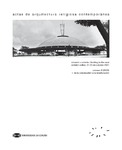Presentación #8

Ver/
Use este enlace para citar
http://hdl.handle.net/2183/30290
A non ser que se indique outra cousa, a licenza do ítem descríbese como Atribución-NoComercial-CompartirIgual 4.0 Internacional (CC BY-NC-SA 4.0)
Coleccións
Metadatos
Mostrar o rexistro completo do ítemTítulo
Presentación #8Título(s) alternativo(s)
Presentation #8Autor(es)
Data
2021-12-13Cita bibliográfica
Fernández-Cobián, E. (2021). Presentación #8. Actas de Arquitectura Religiosa Contemporánea, 8, I-X. Recuperado a partir de https://revistas.udc.es/index.php/aarc/article/view/8833
Resumo
[Resumen] En los comienzos de la modernidad, arquitectos como Frank Lloyd Wright o Antonin Raymond vieron en el Extremo Oriente una oportunidad para huir de los rígidos esquemas beauxartianos y alcanzar una nueva arquitectura. Si entonces la modulación de la casa japonesa y su exquisita armonía con la naturaleza se tomaron como base para una nueva manera de construir, tal vez en la actualidad la arquitectura del Extremo Oriente pueda inspirarnos de nuevo.Por otra parte, en 2021 se cumplen 500 años de la llegada de los españoles a Filipinas y el comienzo de la evangelización de Asia. La confluencia de religiones originó una hibridación de arquitecturas destinadas al culto, que tras numerosas vicisitudes cristalizó en la arquitectura religiosa que contemplamos hoy. Estas arquitecturas constituyen un importante reclamo turístico y, en paralelo, motivo de preocupación para los organismos oficiales encargados de la protección patrimonial de cada país.La enorme actividad constructiva y urbanizadora que se ha desarrollado en esta parte del mundo durante las últimas décadas nos obliga a volver la mirada al Extremo Oriente. ¿Qué arquitectura cristiana se ha hecho allí en los últimos cien años? ¿Qué ideas, qué conceptos se plasman y se reflejan en ella? ¿Qué podemos aprender de estos edificios? [Abstract] At the beginning of modernity, architects like Frank Lloyd Wright or Antonin Raymond saw in the Far East an opportunity to escape from the dominant Beauxartian schemes, and reach a new architecture. If then the modulation of the Japanese house and its exquisite harmony with nature were taken as the basis for a new way of building, perhaps today the architecture of the Far East can inspire us again.On the other hand, in 2021 it will be 500 years since the arrival of the Spanish in the Philippines and the beginning of the evangelization of Asia. The confluence of religions originated a hybridization of architectures destined for worship, which after numerous vicissitudes crystallized in the religious architecture that we contemplate today. These architectures constitute an important tourist attraction and, in parallel, cause of concern for the official organisms in charge of the patrimonial protection of each country.The enormous construction and urban development activity that has taken place in this part of the world in recent decades forces us to turn our gaze to the Far East. What christian architecture has been made there in the last hundred years? What ideas, what concepts are reflected and reflected in it? What can we learn from these buildings?
Palabras chave
Presentación
Presentation
Presentation
Versión do editor
Dereitos
Atribución-NoComercial-CompartirIgual 4.0 Internacional (CC BY-NC-SA 4.0)
ISSN
2659-8671






